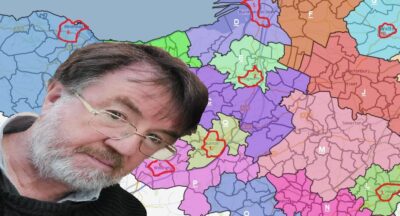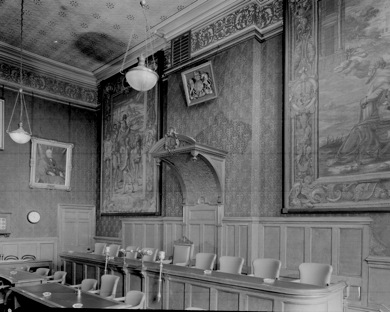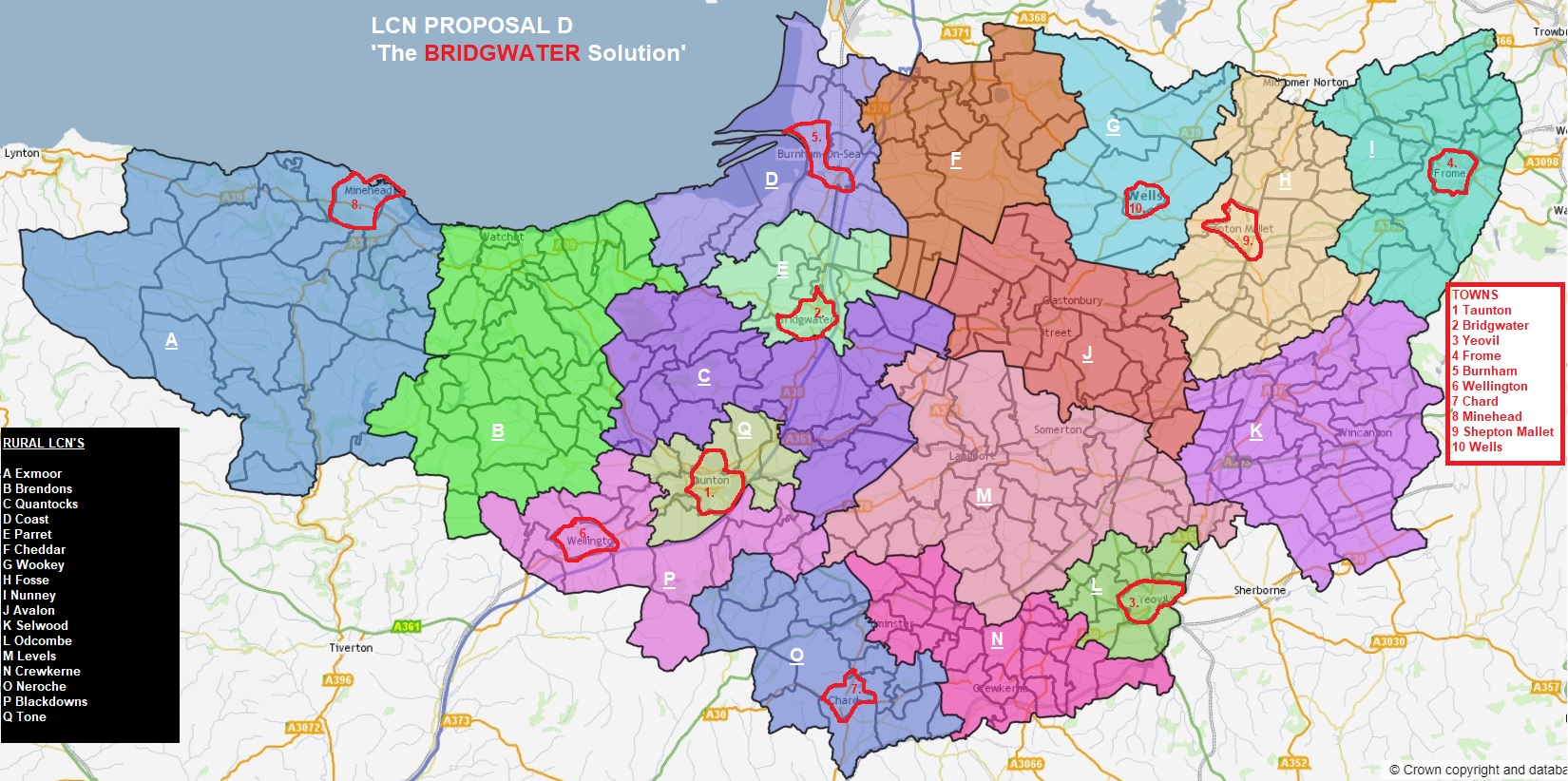
October 17th sees the final day of the Somerset County Council consultation on how LCN’s should work. These ‘Local Community Networks’ were proposed as a kind of intermediate layer between Parishes and the new ‘over large’ Unitary County but how they actually worked and what they looked like wasn’t particularly clear. Cllr Brian Smedley (Leader of Bridgwater Town Council) has submitted an 11th hour alternative ‘Option D’ saying “The idea for LCN’s came about from the business case devised by the previous Tory county council. And they’re no longer in charge. The new Lib Dem administration didn’t want this form of unitary in the first place and so are making heavy weather of the consultation. In reality they may be creating a whole new layer of bureaucracy which probably isn’t needed or can be achieved within the existing structures of Towns and Parishes. The Local Community Networks are not really ‘local’ not particularly ‘ community’ and problem really just ‘networks’ – which shouldn’t cost anything. We’ve therefore come up with a solution here in Bridgwater which we think could work across the county. There’s 10 Town Councils already in existence with 10,000 or more population and they should be supported with enhanced services and ownership of their own assets and then there’s several smaller towns with their own neighbouring hinterlands who can work together or not as they choose. That’s the solution and it would save them money and maintain local democracy.”
The submission by Bridgwater is reproduced in full below.
The LCN Consultation ‘The Bridgwater Solution’
Going into the 2022 County Council elections the Conservative Ruling Group on Somerset County Council had devised and advocated a single ‘One Somerset’ Unitary solution claiming £18 million savings. This was opposed by the 4 districts who felt it was too large and would be too remote for genuine accountability and in turn they proposed ‘Stronger Somerset’, a 2-Unitary solution, which was proven to be more popular with Somerset electors in a postal poll. After the election the Somerset Tories had lost control and the Lib Dems, who had opposed the ‘One Somerset’ project, took control of the County and with it the arrangements for the new Unitary which will be with us on April 1st, 2023. At the same time the predicted £18m savings already looked like a £80m funding gap.

As part of the Unitary project the Local Community Networks (LCN) offered a glimmer of hope that there could be a localist solution to the remoteness of the proposed one large county authority which allowed for the many towns and parishes across the county to organise in groupings potential as sub-regional committees of the council.
During Autumn 2022 the consultation on LCNs came up with numerous proposals and various choices of boundaries based on 3 computer generated options from County. Bridgwater Town Council, which is Labour controlled (alone amongst Somerset authorities) along with the opposition Sedgemoor District Labour Group, would like to make the following submission.
- We need solutions that direct more powers to Town Councils (such as Bridgwater)
- The most local solutions are the best-but only where the communities want them
- There is a danger that ‘LCN’s reflect neither ‘local’ nor ‘community’ and just be a talking shop.
- LCNs mustn’t over-rule or outvote genuine communities
- LCNs are basically Parish clusters, but the geography is hotly contested. It may be the case that the rural parishes ‘could’ benefit from this by combining – but only if they wish – whilst existing historic urban areas (basically town councils) should be preserved and enhanced – often this can lead to the stronger councils providing services to the nearby smaller councils
- In that respect LCNs WON’T provide a mechanism for local action nor promote ‘active community decision making’ as this already exists and needs enhancing in the towns. But it might benefit some rural parishes or small towns with rural hinterlands.
- LCNs can only define priorities ‘within their artificial boundaries’ and this need NOT coincide with Towns priorities
- The main areas considered for devolving to this level are planning and licensing-but these should be decided at principal authority level (SCC in this case) with existing parish planning panels continuing, leaving mainly ‘strategic development’ as the province of LCNs.
- Boundary proposal C is the better of the 3 choices-but only from a political balance, which is a further problem with LCNs in that unitary councillors whose wards cover several LCNs-some even by a toe print -would have an extended reach and influence and therefore be an undue political influence in another community.
- Finally, these options are devised by computers and so there could be options D, E, F therefore We therefore put forward a Proposal D (The Bridgwater Option) with the emphasis on strengthening the existing 10 more populous town councils and same time giving the rural parishes the options of combining ‘as they choose’ within mutual-rural LCNs.
Proposal D: – The Bridgwater Solution

None of the options put forward are workable for everybody nor reflect the actual needs of the TOWN COUNCILS of the county nor the many Parishes which don’t wish to be part of a wider body.
The LCN’s are neither ‘Local’, (enough) or ‘Community’ (as they overlap numerous ‘established’ communities) but merely ‘Networks’ which is fine if the aim is merely to set up ‘talking shops.
The compulsory LCN tier should be abandoned as it fails to recognise the existing Town’s and forces traditional parishes into unnecessary partnerships – which of course Parishes are free to explore anyway rather than be compelled.
This would likely be a major saving within the Unitary plan anyway.
Geography – is the main variable in the move to implementing LCNs. The geography of Somerset is a historic division of Urban and Rural. The 10 established Towns are likely to be extended following the upcoming Boundaries review which needs to align wards to reflect population expansion and concentrate precepts ‘within’ town boundaries not ‘adjacent to.’
Towns and parishes should be recognised separately allowing both to find their natural levels according to their own plans and democratic development and priorities. Example Bridgwater Town Council – which seeks major devolution of services and assets and can deliver these to neighbouring parishes.

Parishes that wish to combine for common purpose are welcome to do this anyway. This could take the form of a kind of LCN either for a specific project or more generally. Example The Heart of the Levels group around Langport-Somerton-Ilchester-Martock area
Some expanding towns with recognisable hinterlands can be similarly supported. Example Glastonbury and Street and surround.
Governance -Instead of compelling towns and parishes to form LCN’s the new Unitary should advocate a ‘bottom up’ form of localism with support structures at county level that recognises the variety and ambition of the different towns and parishes based around the principles of the 7 recommendations of the SALC Charter that was issued at the start of the Unitary process and endorsed by Bridgwater and other Town Councils.
- Partnership working amongst parishes and with the new Unitary
- Methodology of devolution of assets and services should be ‘by request’ from the parishes not enforcement
- The recognition of ‘local solutions’ and the ‘importance of sense of place’.
- Self-identification of their ‘local community’ by the 278 parishes involved
- Staff support presence based locally, spread across the county, and not centralised.
- Cultural and development programme for continued increased engagement
- The voices of the Parishes be heard up to, during and after Unitary.
Whilst in the SALC document LCNs are often referred to as a common solution, these have not always worked in other Unitary authorities around the country and need not be the only way to achieve these 7 goals in Somerset.
In summary the 7 points mean that ALL parishes need to be listened to, self-define their geography and determine their own partnerships and throughout be supported by the Unitary structure.
The geography of option D (The Bridgwater Solution)
A grouping based on the definition of the 10 major towns and ‘possible’ LCN neighbourhood groupings

In this scenario the 10 major towns (above 10,000 population) would be LCN equivalents in their own right and likely wish to provide services to neighbouring hinterlands.
The 17 ‘suggested’ LCN’s, based around option B , are a mix of smaller towns and their neighbourhoods or clusters of rural parishes and need to self-define.
All would have access from the bottom up to the Unitary officers, services, assets and structures as required.
A costly team of officers for each LCN can in this way be avoided
Unitary Councillors along with representatives of town and parish councillors within the 27 identified structures (Town or Rural) would meet to discuss strategically and the unitary members -as was originally planned -would provide the interface with County.

Makes for real accountability. Good job.
This looks eminently sensible to me
The best solution I have seen!
I do hope this gets the attention it
deserves.